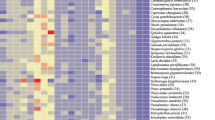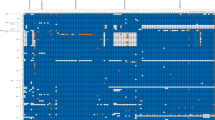Abstract
ThepsbA-trnH intergenic region is among the most variable regions in the gymnosperm chloroplast genome. It is proposed as suitable for DNA barcoding studies and is useful in phylogenetics at the species level. This region consists of two parts differing in their evolutionary characteristics: 1) thepsbA 3′UTR (untranslated region) and 2) thepsbA-trnH intergenic spacer. We compared the sequence and RNA secondary structure of thepsbA 3′ UTR across gymnosperms and found consensus motifs corresponding to the stem portions of the RNA stem-loop structures and a consensus TGGATTGTTATGT box. ThepsbA-trnH spacer is highly variable in length and composition. Tandem repeats that form stem—loop structures were detected in both thepsbA 3′ UTR and the psbA-trnH spacer. The presence of promoters and stem—loop structures in the psbA-trnH spacer and high sequence variation in this region suggest that psbA and trnH in some gymnosperms are independently transcribed. Acomparison of chloroplast UTRs across gymnosperms offer clues to the identity of putative regulatory elements and information on selective constraints imposed on the chloroplast non-coding regions. The present study should inspire researchers to explore the full potential of thepsbA-trnH non-coding sequence and to further stimulate its application in a broader spectrum of studies, not limited to phylogenetics and DNA barcoding.
Similar content being viewed by others
References
Bollenbach TJ, Stern DB, 2003. Secondary structures common to chloroplast mRNA 3′-untranslated regions direct cleavage by CSP41, an endoribonuclease belonging to the short chain dehydrogenase/reductase superfamily. J Biol Chem 278: 25832–25838.
Crooks GE, Hon G, Chandonia JM, Brenner SE, 2004. WebLogo:Asequence logo generator. Genome Res 14: 1188–1190.
Edgar RC, 2004. MUSCLE: multiple sequence alignment with high accuracy and high throughput. Nucl Acids Res 32: 1792–1797.
Gordon L, Chervonenkis AY, Gammerman AJ, Shahmuradov IA, Solovyev VV, 2003. Sequence alignment kernel for recognition of promoter regions. Bioinformatics 19: 1964–1971.
Gruber AR, Neuböck R, Hofacker IL, Washietl S, 2007. The RNAz web server: prediction of thermodynamically stable and evolutionarily conserved RNA structures. Nucl Acids Res 35: W335–338.
Hall TA, 1999. BIOEDIT: a user-friendly biological sequence alignment, editor and analysis program for Windows 95/98/NT. Nucl Acids Symposium Series 41: 95–98.
Hao DC, Huang B, Yang L, 2008. Phylogenetic relationships of the genusTaxus inferred from chloroplast intergenic spacer and nuclear coding DNA. Biol Pharm Bull 31: 260–265.
Hao DC, Huang B, Chen SL, Mu J, 2009. Evolution of the chloroplasttrnL-trnF region in the gymnosperm lineages Taxaceae and Cephalotaxaceae. Biochem Genet 47: 351–369.
Hao DC, Xiao PG, Huang B, Ge GB, Yang L, 2008. Interspecific relationships and origins of Taxaceae and Cephalotaxaceae revealed by partitioned Bayesian analyses of chloroplast and nuclear DNA sequences. Plant Syst Evol 276: 89–104.
Kress WJ, Wurdack KJ, Zimmer EA, Weigt LA, Janzen DH, 2005. Use of DNA barcodes to identify flowering plants. Proc Natl Acad Sci USA 102: 8369–8374.
McCaskill JS, 1990. The equilibrium partition function and base pair binding probabilities for RNA secondary structure. Biopolymers 29: 1105–1119.
Posada D, 2006. ModelTest Server: a web-based tool for the statistical selection of models of nucleotide substitution online. Nucl Acids Res 34: W700-W703.
Reese MG, 2001. Application of a time-delay neural network to promoter annotation in theDrosophila melanogaster genome. Comput Chem 26: 51–56.
Ronquist F, Huelsenbeck JP, 2003. MrBayes 3: Bayesian phylogenetic inference under mixed models. Bioinformatics 19: 1572–1574.
Sass C, Little DP, Stevenson DW, Specht CD, 2007. DNA barcoding in the cycadales: testing the potential of proposed barcoding markers for species identification of cycads. PLoS One 2: e1154.
Shahmuradov IA, Solovyev VV, Gammerman AJ, 2005. Plant promoter prediction with confidence estimation. Nucl Acids Res 33: 1069–1076.
Song J, Yao H, Li Y, Li X, Lin Y, Liu C, et al. 2009. Authentication of the family Polygonaceae in Chinese pharmacopoeia by DNA barcoding technique. J Ethnopharmacol 124: 434–439.
Storchova H, Olson MS, 2007. The architecture of the chloroplastpsbA-trnH non-coding region in angiosperms. Pl Syst Evol 268: 235–256.
Tajima F, 1989. Statistical methods to test for nucleotide mutation hypothesis by DNA polymorphism. Genetics 123: 585–595.
Tamura K, Dudley J, Nei M, Kumar S, 2007. Mega4: molecular evolutionary genetics analysis (MEGA) software version 4.0. Mol Biol Evol 24: 1596–1599.
Yao H, Song JY, Ma XY, Liu C, Li Y, Xu HX, et al. 2009. Identification ofDendrobium species by a candidate DNA barcode sequence: The chloroplastpsbA-trnH intergenic region. Planta Med 75: 667–669.
Zuker M, 2003. Mfold web server for nucleic acid folding and hybridization prediction. Nucl Acids Res 31: 3406–3415.
Zwickl DJ, 2006. Genetic algorithm approaches for the phylogenetic analysis of large biological sequence datasets under the maximum likelihood criterion. Ph.D. dissertation, University of Texas, Austin.
Author information
Authors and Affiliations
Corresponding author
Rights and permissions
About this article
Cite this article
Hao, D.C., Chen, S.L. & Xiao, P.G. Sequence characteristics and divergent evolution of the chloroplastpsbA-trnH noncoding region in gymnosperms. J Appl Genet 51, 259–273 (2010). https://doi.org/10.1007/BF03208855
Received:
Accepted:
Issue Date:
DOI: https://doi.org/10.1007/BF03208855




